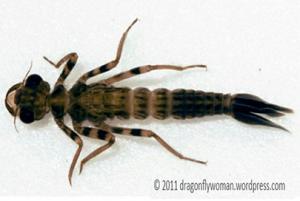‘Tis but a Scratch! Damselflies Lose a Limb to Escape Predators in the Nick of Time
By Alana Wilcox
22 May 2019

Peering into the ponds around Guelph, Katherine Black pushes the long-handled net through the plants along the water’s edge, checking the mesh every few seconds for aquatic insects. Nothing yet. A few more dips and she finds what she is looking for – damselfly nymphs, the juvenile aquatic stage of the thin-bodied insect often seen darting above the waterways in summer.
Black was an undergraduate thesis student in Dr. Beren Robinson’s lab in the Department of Integrative Biology when she began examining the evolutionary underpinnings of predator-prey relationships. She was particularly interested in what happens between damselfly nymphs and one of their most common predators: dragonfly larvae. Large dragonfly larvae are one of the top dogs in the aquatic insect world, lying in waiting to ambush prey or actively patrolling ponds, forcefully expelling water to propel themselves as they attack. When prey is encountered a specialized mouthpiece, called a labium, is rapidly extended to capture the unsuspecting victim.
For many prey victims this would be the end of story, but according to Robinson, damselfly nymphs “have a final get out of jail card.” At the end of their long, slender abdomen rest three feathery structures called lamellae, which play a role in breathing and swimming. These lamellae are attached by a joint to the end of the abdomen, and can break off when a predator latches on, a process biologists call autotomy. This self-amputation “permits escape and survival after a dragonfly larvae attacks,” explains Robinson.

courtesy of C. Goforth, www.thedragonflywoman.com
Black and Robinson were interested in investigating if the damselfly nymph can make the joint break more easily when dragonfly predators are present in the pond. A joint that ruptures readily would allow damselfly nymphs to escape quickly if caught, maximizing their chance of survival. However, damselfly nymphs go through 10 moults throughout their lifetime and weak joints could just as easily break during growth, which could harm a nymph’s respiration and movement. This means that the ease with which the joint breaks “is a trade-off between the immediate risks of mortality from a grasping predator and the risk of post-amputation costs,” says Black.
To find out how the presence of predators might affect how damselfly nymphs regulate this trade-off, Black set up large water tanks containing multiple small enclosures that held individual nymphs. In half of the tanks, a single large dragonfly larva patrolled outside of the enclosures and was fed damselfly nymphs on each day of the experiment. Chemical cues released from damselfly prey when injured during an attack can be detected by the enclosed damselflies, and so reveal the presence of predators. After the nymphs spent at least a month in the tanks with or without exposure to predator cues, Black then measured each damselfly with a specialized piece of equipment that allowed her to determine the amount force required to rupture the joint. She discovered that the presence of predators affected the physical structure of the joint, resulting in thinner joints that were more easily broken, and allowing the nymphs to more readily escape potential predators.
These exciting results shed new light on evolutionary processes. Selection is rarely just about “the presence or absence of a trait,” Robinson says. “Selection can also favour the ability of an organism to alter a particular trait during its lifetime, a phenomenon known as ‘plasticity’, particularly when the costs and benefits of the trait change in time or space. In this case, plasticity made it easier or harder for autotomy to happen depending on the predation risk.”
Black has since completed her graduate studies and is now an ecological consultant, but other undergraduate students with a keen interest in evolutionary biology are continuing this work in the Robinson lab. Their goal now is to determine how damselfly behaviour and the structure of the joint affects how and when it breaks. Such studies promise to reveal even more fascinating complexities in the “bug eat bug” world of your local pond, and the wider natural world beyond.
Will Jarvis and Douglas Fudge, University of Guelph, also contributed to the study.
Read the full study in the journal Evolutionary Ecology.
Read about other CBS Research Highlights.